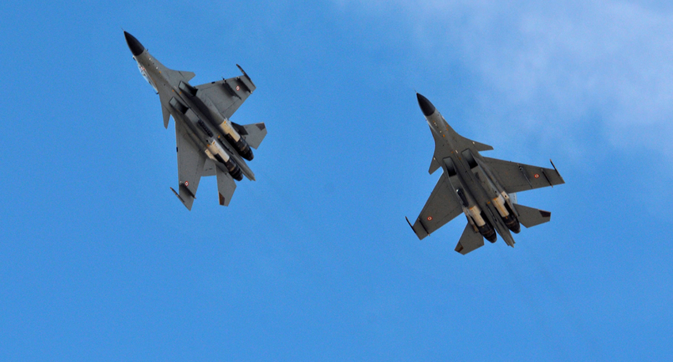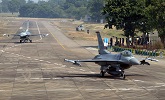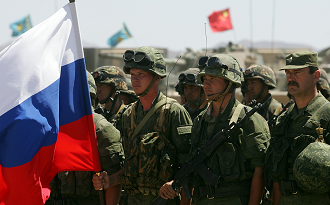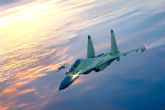Dissecting a dogfight: Sukhoi vs USAF at Red Flag 2008

Su-30 fighter planes during Red Flag joint exercise by Indian and US Air Force, over the Nevada desert, USA, on August 21, 2008. Source: AP
It was the first time the legendary Russian Sukhoi-30 Flanker flew in American airspace, and it kicked up a controversy. In August 2008 India sent its top of the line Su-30MKI fighter to participate in Exercise Red Flag at Nellis Air Force Base near Las Vegas. Known for its complex war gaming, Red Flag involves simulated air combat and coordination between friendly air forces. In 2008 the participants included the French and South Korean air forces.
The IAF contingent – comprising six Flankers, two Illyushin IL-78MKI tankers and one IL-76MD transport – initially arrived at Mountain Home AFB in Idaho on July 17. The fighter pilots of No. 20 Lighting Squadron from Pune underwent a three-week familiarisation with training rules, and flew missions against the 18th Aggressor Squadron from Eilson AFB, Alaska, and the resident 366th Fighter Wing.
Combat begins
The IAF moved to Nellis AFB on August 9. “To observers’ dismay, and no doubt to that of the US intelligence community, the IAF flew with a number of handicaps," writes Dave Fulghum of Aviation Week.
The Su-30MKI’s powerful Russian-made NIIP-BARS radar was operating only in the training mode which limited the sensor’s range and spectrum of capabilities. The self-imposed radar restrictions prevented US snoops from "mapping" the high-tech radar. But other restrictions were dictated by the hosts, Fulghum writes.
The Indians were barred from using data-links, chaff and flares. When they were targeted by surface to air missiles, they were shot down. There was no data picture in the cockpit to help IAF pilots’ situational awareness so the work load on the aircrews was high. Also, the IAF’s most powerful air-to-air missile, the R-77, was not simulated in the exercises.
Rogue video
Although the results of such exercises are rarely made public, the USAF jumped the gun. Just as it leaked the results of Cope India 2004, in November 2008 a video surfaced of a US Air Force officer talking in a generally condescending manner about the IAF. In particular five things that Col Terence Fornof said stick out:
- The IAF has problems with its Russian jet engines
- Indian pilots were prone to fratricide – shooting down friendly aircraft
- The IAF required 60-second intervals between takeoffs, compared with half that for other air forces
- The American F-15 can defeat the Su-30MKI, the most advanced fighter in the Su-30 series
- IAF not keen on 1 vs 1 dogfights with the USAF.
Low blow
Speaking about the encounter between the Su-30MKI and the F-15Cs, Fornof said: “The (IAF pilots) were amazed, matter of fact they were floored to the point after the first three days, they didn't want any more 1 vs 1 stuff. Let’s move on to something else (laughs). Funny ’cause in India, they wanted only 1 to 1 – ’cause they were winning at that.”
About the engines, he said: “Firstly, the Tumansky engines are very susceptible to FOD (foreign object damage). Now the reason that’s a big deal is because they asked for a one-minute spacing between take offs. At Red Flag with nearly 50-60 aircraft supposed to take off, if you have one person who will wait one minute between each take off to launch these six aircraft... yeah.... right, they can go find some other place to fly.”
And he added: “They were very concerned about FOD and how Russian engines are not nearly as reliable as American (ones).”
Playing to the gallery
Col Fornof is an F-15 pilot and the Director of the Requirements and Testing office at the United States Air Force Warfare Center, Nellis AFB. The video was of a private briefing days after Red Flag 2008 to a group called the Daedalians – a group of retired American military pilots.
While it is true the colonel was involved with Red Flag 2008, Vayu Aerospace Review says his comments should not be taken too seriously because there is a possibility he was playing to the gallery. “His comments are noteworthy since he is an operational pilot with the USAF but he certainly cannot cover the entire exercise and has no inside knowledge of the way IAF ‘fought’.”
In fact, Col Fornof is mistaken on several counts. For instance, the Su-30MKI does not have a Tumansky engine but rather an NPO-Saturn power plant. He is wrong again about the MiG-21 Bison having Israeli radar when in fact it has a Russian scanner. He’s wrong on most counts and in fact economical with the truth in some places.
From the frontlines
Among the observers who had front row seats to the dogfights was senior Indian journalist Vishnu Som. According to him, contrary to the picture painted by Fornof, the IAF and its Sukhois more than made a mark during their stint in the United States. “For starters not a single Su-30MKI fighter was shot down in close air combat missions at Mountain Home AFB. In fact, none of the Sukhois were even close to being shot down in the 10-odd one on one sorties which were planned for the first two days of the exercises at Mountain Home. These one on one engagements featured USAF jets such as the F-15 and F-16 in close air engagements against the Su-30MKI. The majority of the kills claimed in these engagements were granted to the IAF with the remainder of these being no-results.”
Som adds by the time the exercises at Mountain Home had matured the IAF had graduated to large formation exercises which featured dozens of jets in the sky. In one of these exercises, the blue forces, of which the IAF was a part, shot down more than 21 of the enemy jets. Most of these `kills’ have been credited to the IAF.
Bad PR
Pushpindar Singh Chopra, editor, Vayu Aerospace Review, believes the Americans downplayed the Sukhoi’s capability because the alternative would be to acknowledge the IAF had spooked the USAF yet again.
“Mission achievement rate was in excess of 90 per cent,” he says. “The drop out/mission success rates of all others, inclusive of the USAF, were significantly lower. This is of major significance considering the fact that IAF was sustaining operations 20,000 km away from home base while the USAF was at home.”
In fact, the Sukhois flew some 850 hours during the deployment, which is equivalent to four months of flying in India.
Fratricide bogey
Chopra says while the IAF did shoot down some friendlies and that was assessed and attributed to the IAF not being networked. However, what Col Fornof did not bring out were the two essential reasons for this.
“Firstly, this occurred mainly when the AWACS was not available (unserviceable) and controlling was done by ground control. More significantly it happened during extremely poor controlling by their operators, this fact being acknowledged during debriefs and the controllers being admonished accordingly.”
What Col Fornof left out was the F-15C and other USAF fighters had the same number of fratricides as the IAF. “Considering they are well networked, yet their pilots shot down the same number of friendlies. This was not only a major concern but also turned out to be a major source of embarrassment as the USAF had everything – Link 16, IFF Mode 4 etc and the IAF had nothing.”
Gone in 60 seconds
The IAF insisted on a 60-second interval for a very valid reason. When a jet takes off, the resulting turbulence can kick up foreign objects from the runway, which may get sucked into the engines of the aircraft taking off behind it. Now, the Su-30MKI engines are serviced in Russia. What the Russians do when a damaged engine arrives from India is they send a brand new ‘courtesy’ engine as replacement while the old one is being repaired or serviced, in order not to impact the IAF’s readiness.
While at Nellis, the IAF had absolutely no way of getting a new engine had a Sukhoi engine got damaged. Plus, the Russians would have been decidedly cagey about shipping one of their top-of-the line power plants to an American address.
Flanker vs Eagle
According to Col Fornof, beating the Su-30 is not a problem for an F-15 pilot. “We've been fighting the (F-22) Raptor, so we've been going oh dude, this is easy. So as we're fighting him, all of a sudden you'd see the ass end kick down, going post stall - but now he starts falling from the sky. The F-15 wouldn't even have to pull up. slight pull up on the stick, engage guns, come down and drill his brains out.”
If only real combat was that easy. The colonel wrongly assessed the Sukhoi’s rate of turn at 22-23 degrees but he also made the startling revelation that the Raptor’s was 28 degrees. Did he unwittingly reveal classified information? At any rate, the Sukhoi’s rate of turn – with thrust vectoring – is considerably superior at 35 degrees.
It is acknowledged in aviation circles the Flanker is a class above the F-15. In Fornof’s own view a well-flown F-15 can trouble an F-22; so a properly flown Flanker can potentially kill a Raptor in a knife fight.
As Col Fornof himself said about the IAF, “They were extremely professional – they never flew out of the airspace which we were very concerned about. They had zero training rule violations. And that in itself was incredible. We were very impressed and thanked them so much because they were very very professional.”
The best outcome of Red Flag 2008 was that it was a unique experience for Indian pilots who were keen to observe the USAF’s Net-Centric Warfare operations. “You cannot survive today for long against a good adversary without NCW capability," said then IAF vice chief Air Marshal P.V. Naik.
As for the Americans, they also got a chance to get rides on the Flanker, “a thrilling opportunity especially for the local pilots” according to the military aviation website, Milavia.
All rights reserved by Rossiyskaya Gazeta.
Subscribe
to our newsletter!
Get the week's best stories straight to your inbox


